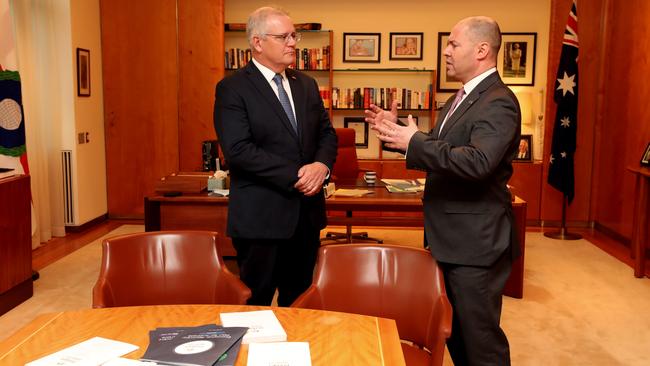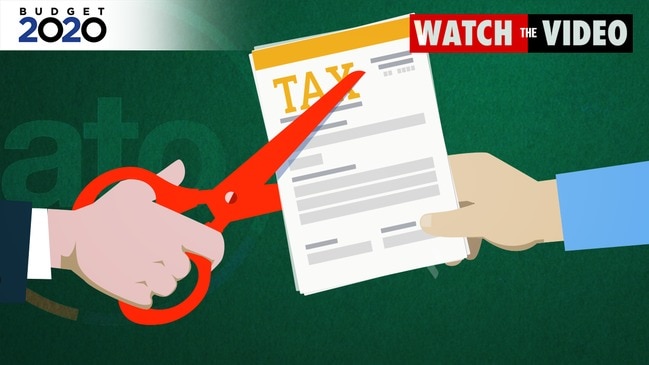What the 2020-21 Federal Budget means for SA
Nearly 800,000 South Australians will be eligible for tax cuts, and 300,000 SA businesses set for new tax incentives in Tuesday’s Federal Budget. But our GST is set for a huge drop.

SA News
Don't miss out on the headlines from SA News. Followed categories will be added to My News.
Tax cuts of up to $5490 for families and $2745 for singles have been unveiled in a historic federal budget that splashes $98bn of extra measures to drive Australia out of recession and create 950,000 jobs within four years.
The federal budget will plunge $213.7bn into the red while Australia’s gross debt will hit $872bn this financial year and balloon to $1.13 trillion by 2024.
Treasurer Josh Frydenberg said the debt would be a “heavy burden” for Australians but was necessary to tackle “the greatest challenge of our time”.
“The Great Depression and two world wars did not bring Australia to its knees, neither will COVID-19,” he said.
“There remains a monumental task ahead. But there is hope. Australia is up to the task.”
He said the Budget would be the start of “the next phase” of Australia’s recovery from COVID-19.

About 790,000 South Australians will be eligible for tax cuts, while 300,000 SA businesses will be eligible for new tax incentives, including a temporary extension of the instant asset write-off that will allow businesses up to $5bn to fully write off new assets.
SA will get a $625.2m cash injection for infrastructure projects and will share in $2bn for “shovel-ready” road safety upgrades across Australia.
But SA’s GST will drop by more than $1bn to $5.6bn in a major hit to the state’s coffers.
Families will get tax cuts of up to $5490, while singles will get up to $2745 in a $17.8bn package, which brings forward stage 2 tax cuts already scheduled for 2022 and extends a tax offset for low and middle income earners for another year.
Stage 2 tax cuts will be backdated to July 1, and will lift the top threshold for the 19 per cent tax bracket from $37,000 to $45,000, and from $90,000 to $120,000 for the 32.5 per cent tax bracket.
It will mean hip-pocket relief for about 11 million Australians and will pour “billions” back into the economy and create 50,000 new jobs, Mr Frydenberg said.
Pensioners will get two payments of $250 in December and July, after the age pension was frozen when inflation went backwards, in a $2.6bn package.
A wage subsidy will be launched from Wednesday for businesses to hire young workers aged 16 to 35 currently on JobSeeker to work at least 20 hours a week.
The government will also pay half of the wages for new apprentices and trainees for a year, or up to $7000 a quarter, in a $1.2bn package to create 100,000 new apprenticeships.
For businesses, Mr Frydenberg said the instant asset write-off expansion would be a “game changer” that will unlock investment, boost productivity and create “tens of thousands of jobs”.
“A trucking company will be able to upgrade its fleet, a farmer will be able to purchase a new harvester and a food manufacturing business will be able to expand its production line,” he said.
Businesses will also get temporary loss carry-back measures, which means they can offset losses incurred until June 2022 against profits made in or after 2018-19.
The NDIS will get a $3.9bn injection, while $2bn will go towards water infrastructure projects such as dams, weirs and pipelines.
The $2bn for “shovel-ready” road safety upgrades will come with a “use it or lose it” provision to ensure construction jobs are created quickly.
The $25,000 HomeBuilder cash grants have not been extended but an extra 10,000 loans for new homes will be made available under the first home buyers’ scheme.
An extra $1bn will go towards low cost finance for community housing providers to boost social housing.
About $240m was set aside for projects specifically to help women, who have been hit hardest by the crisis.
That will include $50m to support women’s job creation in male-dominated industries, money to create 500 new cadetships and apprenticeships in STEM, and measures to tackle sexual harassment in the workplace.
Unemployment will peak at 8 per cent in December quarter – much higher than the Global Financial Crisis but not as bad as the Great Depression – before falling to 6.5 per cent by next June.
It should drop to 6 per cent in 2022 and to 5.5 per cent by 2024, meaning the Federal Government will begin its strategy to get deficit and debt down within two years.
Australia is forecast to be out of its first recession in almost 30 years by 2021, when the economy is tipped to grow by 4.25 per cent. The economy is predicted to shrink by 3.75 per cent this year.

Historic budget – but is it enough?
Analysis – Claire Bickers
When we look back on today, the question won’t be ‘Did we dig too deep a hole?’, it will be, ‘Did we do enough?’
More than 1.4m Australians don’t have a job right now, including more than 110,000 in South Australia.
Tens of thousands more workers are likely to join Centrelink queues in the next six months as JobKeeper winds down and ends in March.
And there are fears the crisis will leave permanent ‘labour-market scarring’ on young Australians if they don’t get into work quickly.
The Reserve Bank is also anticipating a wave of business closures.
Josh Frydenberg has unveiled a mammoth $98bn worth of new spending to tackle COVID-19 relief and recovery, bringing the total spend since the pandemic began to $507bn.
It’s the Budget we had to have to tackle an unprecedented crisis, even if in some ways its blunt instrument that doesn’t go far enough to tackle issues exposed by the crisis – such as the massive hit to women or need for childcare reforms.
There are measures to get young people back into the workforce, including $1.2bn to pay half the wages of new trainees and apprentices and $4bn for incentives to encourage businesses to hire young workers.
There is a raft of help for businesses, tax cuts will flow to 11 million Australians and pensioners will get two payments of $250.
There is about $10bn of infrastructure projects, a $1.5bn manufacturing roadmap, and a $1.9bn roadmap for new energy projects, which will help create jobs and rebuild.
But as the saying goes, don’t waste a crisis.
Big nation-building projects could have been given more funding, and $625m for SA infrastructure projects, including $200m in upgrades for Hahndorf, doesn’t go far enough.
Just $240m in measures specifically for women also isn’t enough.
And yes, we will be paying off this crisis for a generation.
But with interest rates at record lows, it’s better to spend big now, than wish we had later.

